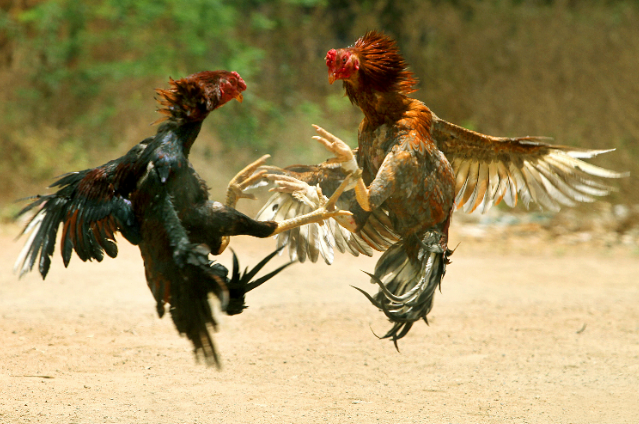INTRODUCTION
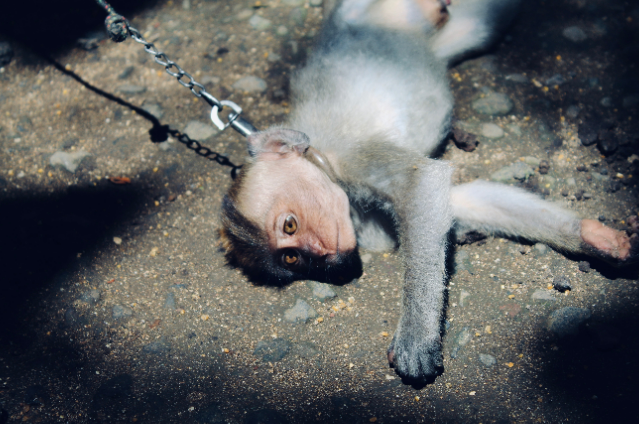
Cruelty to animals, also called animal abuse, animal neglect or animal cruelty, is the infliction by omission (neglect) or by commission by humans of suffering or harm upon non-human animals. More narrowly, it can be the causing of harm or suffering for specific achievements, such as killing animals for entertainment; cruelty to animals sometimes encompasses inflicting harm or suffering as an end in itself, defined as zoosadism.
There are a number of festivals that celebrate Animals in India. However, today it is mostly narrowed to people abusing animals in the name of celebrating them, in the name of worshipping God. People perform some rituals simply because they are traditions, and forget to have compassion towards animals. Similarly, there are a number of sports and traditions that are still practiced despite of the awareness about animal cruelty it creates. In this article, we are going to discuss a few of such traditions and celebrations that are more of cruel, along with some Laws that protect animals in India.
1. JALLIKATTU:
Jallikattu is a sport conducted as a part of Mattu Pongal. The Mattu Pongal is the 3rd day of the four-day-long festival Pongal. It is also known as Manju Virattu or Eru Thazhuvuthal. 'Jallikattu' evolved from the words 'Calli' (coins) and 'Kattu' (tie), which denotes a bundle of coins tied to the bull's horns. The bulls are released into a crowd of people, and multiple human participants attempt to grab the large hump on the bull's back with both arms and hang on to it while the bull attempts to escape. Participants hold the hump for as long as possible, attempting to bring the bull to a stop. In some cases, participants must ride long enough to remove flags on the bull's horns.
While 2019 marked the second year when Jallikattu was carried out legally in the state, PETA India has documented evidence of extreme animal cruelty during the Jallikattu events.
PETA India's 2019 investigations revealed that bulls were hit with bare hands, whipped, and jabbed with wooden sticks. Their tails were bitten, twisted, and yanked to force them to run towards the menacing crowd.
The report also stated that their nose-ropes were roughly yanked, causing their nostrils to bleed.
This triggered the injured bulls to charge through village streets, often injuring onlookers and even goring some to death. PETA India further said that bulls used for the event sustain multiple injuries and some even collapsed from exhaustion.
Data collected by the organisation reveal that at least 42 humans, 14 bulls, and one cow have died during the events held since jallikattu was permitted again under the Prevention of Cruelty to Animals (Tamil Nadu Amendment) Act, 2017.
Year after year, PETA India's investigations tell the same story of mass human and bull deaths and of bulls being deliberately tormented and forced to take part in jallikattu," says PETA India CEO Dr. Manilal Valliyate.
"Jallikattu is an inherently abusive and dangerous practice that has no place in our modern and progressive society. PETA India is calling for an immediate reinstatement of the ban on these cruel events," the organisation said.
Investigations of jallikattu events by PETA India in 2017, 2018, and 2019 and inspections by the Animal Welfare Board of India from 2008 to 2014 consistently found cruelty to bulls in violation of the central as well as state law.
2. GADHIMAI:
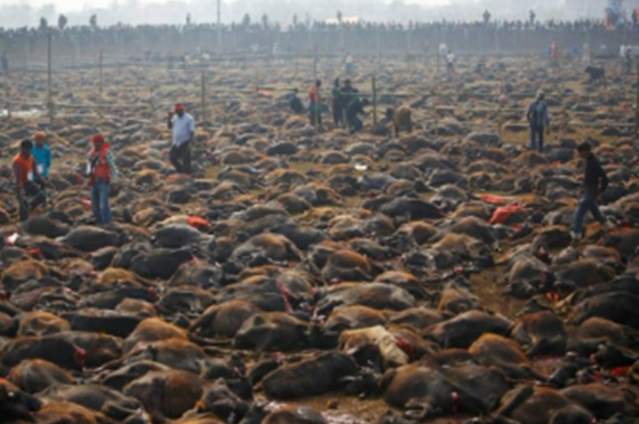
According to Hindu Legend, The goddess of Power, Gadhimai came into a prisoner’s dream and asked him to build a temple for her. The moment he woke up and found he was free, he constructed a temple of the goddess and sacrificed an animal in return. The goddess never asked to sacrifice the animal. We all are children of God. The Almighty wants to keep every child happy, including animals.
It is a belief for the last 250 years that Goddess Gadhimai would fulfill all the wishes of people sacrifice an animal in the temple. And this tradition is ongoing and kills thousands of animals every five years in the Nepalese village, Bariyarpur, close to the Indian Border.
The animals are brutally slaughtered in the name of the festival. The festival killed approximately 500,000 in 2009, and 30,000 in 2014 animals including buffaloes, pigs, goats, chickens, rats, and pigeons. The animals are beheaded brutally by sharp knives, Kukri, in the name of spiritual significance. It has been reported that animals have been transported to Nepal Border from India.
The most massive mass slaughter on the planet, “The Bloodiest Festival” took place in Nepal despite all the objections from Animal Rights Groups. It was also directed by Gadhimai Temple Trust, that no animal would be sacrificed that year(2019). Nepal’s central government refused to grant the fund for the festival, looking to the Supreme Court’s ban on the sacrifice of animals. Still, the animals were sacrificed. Many animals were in the queue on the path to death. The recorded number of slaughtered buffaloes was approximately 2000. Thousands of people witnessed the bloodiest festival, believing Goddess Gadhimai would fulfill their wishes. The brutal act is considered to be an integral part of the tradition.
And not to end here, the brutality is not restricted to just slaughter. These animals are transported illegally in trucks, shriveled from dehydration, lack of food and water, and waiting for their death so that they can be relieved from this traumatic journey. This needs to be stopped, and we need to understand our traditions and stop this brutally in the name of blind faith and tradition.
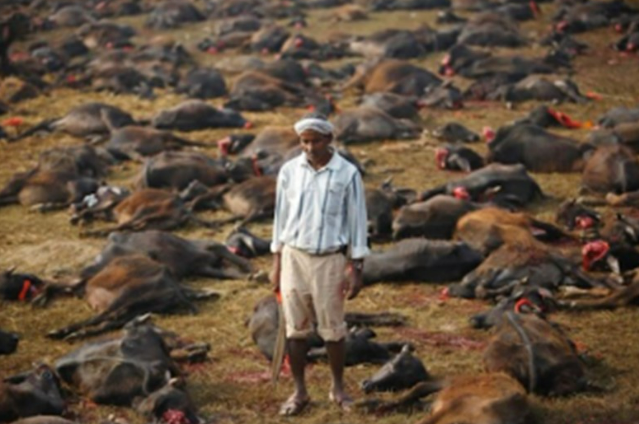
"Like the butcher, I too felt a little bit haunted."
Image by Naresh Chitrakar, Reuters
3. FOX-HUNTING:
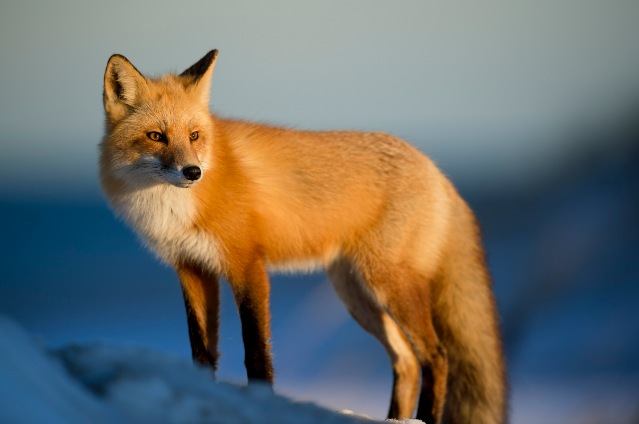
Kadaballi is a village on the Bangalore-Mangalore national highway in the Nagamangala taluka of Mandya. Its deity is Kaveti Ranganatha. This deity is to be worshipped with live foxes on the day after the harvest festival of Makar Sankranti.
The hunting of foxes begins the day before Sankranti and takes three days. Nets, that are blessed by the temple, are used to hunt them in the valleys of the Kadaballi region, Kadhali Gudda Valley spreading out to Hassan district. The hunters split into two groups. The first group beats drums and blows horns to drive the foxes from their hideaways. The other group waits with nets outside the holes. Scared by the noise, the foxes rush out and are captured.
The more that are caught, the luckier the village. Usually, five to ten foxes are trapped. Sometimes, the foxes are killed while being captured and are buried on the spot, which becomes a "sacred" place. These are the lucky ones. The captured foxes are brought back, with their mouths and legs tied, and kept in a pen behind the temple. About 30,000 people congregate for the "festivities", the liquor flows, and firecrackers explode. At 10 pm, the trussed foxes, already half-dead with fright, are dragged out. Their ears are pierced with gold rings and they are stuffed onto a decorated chariot and taken in a noisy procession of drums, cymbals, and dance to the temple. There, the animals are garlanded, and water is sprinkled on them. Firecrackers are tied to their tails and lit. Their legs are untied and they run into the night with their tails on fire. Most die of their wounds.
Dhanaganahalli in Mysore Taluka also has "fox-worship". Here, they are even more brutal. The foxes have their mouths sewn shut with ordinary needles and thread (think of that happening to your mouth). With blood dripping from their mouths, the defenseless animals are presented to the deity. After that, their lower right ears are cut off and stray dogs, who have been captured days in advance and kept hungry, are let loose on the tied animals. Mauled, bleeding, dying, the foxes are let loose.
Ask the villagers why they do this and they answer that they regard the fox as an incarnation of God. A local paper gave a large photograph of the ceremony. It shows a tiny red fox, its tongue sticking out of its tied mouth while the surrounding urchins push and pull at it with ropes.
The Indian fox (Vulpes bengalensis) is found in southern India. It is a self-reliant and solitary animal that eats food ranging from berries, plant material, and offal, to small birds and rodents. Food, that is not immediately needed by the animal, is buried. It has silvery red, thick, long fur, a bushy tail and upright ears. It makes no great demands from its environment, living in rabbit dens which it enlarges, or digging its own holes. Sometimes, it even shares its den with other animals, wild cats, rabbits, and even owls. Apparently, a peace treaty is in operation.
It does not wander too far from its den — and so villagers, who keep a sharp lookout for these holes throughout the year, have an easy time capturing it. Fox calls range from a soft whimpering or purring, the sound between mother and child, a howl which is an abandonment or loneliness call, to a loud yapping when threatened.
The belief that a fox raids villages for its chickens or piglets are greatly exaggerated. In fact, the fox is so timid that, were it to venture near human habitation, it usually takes one aggressive rooster to drive it off.
As it is, young foxes have a very high mortality rate. The female bears three to five young, but most die before they become independent. If the mother is killed, the father takes over the rearing. In fact, as soon as the young are born, the father starts bringing food for the mother to the den. He takes his family for a "walkabout" when they become old enough to see the world. The family unit is a loving, caring one.
The ability of the fox to elude its hunters is extremely limited. They can be hunted year after year at the same sites. It can be easily attracted by imitating its call and it comes readily, throwing caution to the winds. It does not understand even the rudiments of disguise. It will often fail to jump into an available hole till its hunters are gone. It will not run into the water to disguise its scent — while even deer do that. It is simply a shy and anxious creature that lives as best as it can on whatever is available. The Indian fox is small and lacks the strong odour of other foxes. It even makes a good pet. This is the animal that villagers in Karnataka deify and then mutilate and kill.
4. BULBUL FIGHTS:
The Indian Express reported that on the occasion of Assam's harvest festival of Magh or Bhogali Bihu – which coincides with Makar Sankranti – bulbul fights are organised in the Shri Hayagriva Madhava temple in Hajo, about 50 km from Guwahati.
Local people use bamboo traps to catch the birds and they are prepared for the fight with a meal containing "bananas, a small quantity of cannabis, locally available intoxicating herbs, black pepper, cloves and cinnamon", the description on the video reads. A report in North East Today also says that the birds are prepared for the fight by spiking their food with marijuana, after which they are starved the night before the fight.
The hungry birds are then goaded to fight each other, with food being dangled before them. Once one of the birds emerges stronger, the fight is considered over and the birds are released, the losing bird's crest is trimmed so it does not enter a contest again. There is no betting on the fights and the prizes include a trophy and money for the winning bird's owner
The birds were kept in open space and not in cages, while the string around their feet was tied loosely so that the bulbuls were in no way injured, they claimed.
The Gauhati High Court has banned the traditional bulbul bird fight at the Hayagriva Madhab Mandir, an ancient pilgrim center at Hajo in Assam after considering various provisions of the Wildlife Protection Act 1972 and Prevention of Cruelty to Animals Act 1960.
A report in The Asian Age adds:
"It is difficult to imagine bulbuls fighting for anything more than a perch. But they can, especially when bred and trained like roosters that often fight to the death with sharpened beaks, claws, and razor blades. And all the while, millions change hands in illegal bets...Hundreds of bulbuls are carried to the temple and starved for a couple of days to make them angry."
5. COCK FIGHTING:
Cockfighting is a blood sport in which two roosters specifically bred for aggression are placed beak to beak in a small ring and encouraged to fight to the death.
In organized cockfights, the roosters’ natural fighting instincts are exaggerated through breeding, feeding, training, steroids, and vitamins. A bird may undergo several months of training before a fight, which may involve running long obstacle courses (and even treadmills) and practicing fights with other roosters. Just before a fight, most of the bird’s feathers are plucked and the breeder cuts off the animal’s wattles—the combs below the beak—so that his opponent cannot tear them off.
Once in the ring, roosters often wear knives or artificial gaffs (long, dagger-like attachments) that are sharp enough to puncture a lung, pierce an eye or break bones in order to inflict maximum injury. Fights may be held in abandoned factories, backyards, or even basements and can last anywhere from a few seconds to 15 minutes. While the rules usually do not require one or both birds to die in order to declare a winner, death is often the outcome due to the severity of injuries.
Besides being cruel to animals, cockfighting is closely connected to other crimes such as gambling, drugs, and acts of violence. Bets on the fights can range from a few hundred to thousands of dollars, depending on the reputation of the breeder’s birds. Attendees can sometimes even purchase box seats the way you would for a sporting event.
Illegal weapons have also been found at cockfights because of the large amounts of cash present, and law enforcement raids across the country have established that cockfights are well attended by gang members, further encouraging violence and illegal drug use. To avoid suspicion, organizers regularly move the events to new locations. Despite these unsettling facts, cockfights often inspire a party-like atmosphere in which entire families gather, including children.
6. HOLI:
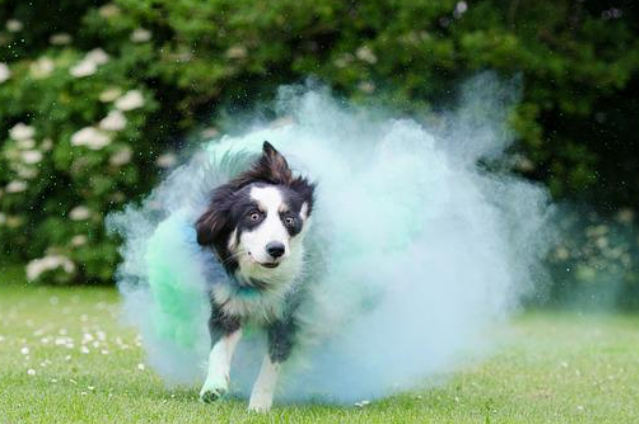
Admit it, We all have witnessed at least one helpless animal who was unwillingly included in the celebration of the Holi festival. Many pictures and videos surface and resurface on the internet year after year about how the festival results in animal abuse.
Holi is a Hindu festival that celebrates spring, love, and new life. Some families hold religious ceremonies, but for many Holi is more a time for fun. It's a colourful festival, with dancing, singing, and throwing of powder paint and coloured water. Holi is also known as the "festival of colours".
But even if it is a 'fun' festival for human beings, I promise you, it isn't fun at all for the poor animals, who can't speak for themselves. It is only harmful and damaging to them.
Most dry colors used during Holi contain chemicals like Mercury Sulfate and metal oxides. These are known to induce skin allergies and inflammation in dogs and other animals.
Furry animals, the most common being dogs, don't have sweat glands, and hence, their body ends up absorbing all the chemicals from colors, even those labelled organic and non-toxic.
Animals are also prone to ingesting colors as they frequently lick themselves to clean up, which poses danger to their digestion patterns. It can cause intestinal erosion and diarrhea.
Excess exposure of animals to colors might to lead to skin allergies like dermatitis, inflammation on the skin, hair loss, severe itching, nasal irritation and respiratory discomfort.
The powdered colors usually contain toxic chemicals which cause skin allergies, rashes and even blindness in animals. The presence of lead in these colors, which can act as an accumulative poison, is a high-risk material for pets. Puppies and smaller animals are the most vulnerable to this kind of exposure.
Any chemical or natural color that can enter the animal's body through the skin, mouth, eyes or nose can also cause various types of allergies, vomiting and blindness.
7. NAG PANCHAMI:

Image by Silvia from Pixabay
Another festival that harasses animals in the name of celebrating them would be Nag Panchami. Now let me tell you what Nag Panchami is. Nag Panchami is held in honour of the serpent god, Naag Devta, to pay tribute to him. It is celebrated on the fifth day of the moonlit-fortnight in the month of Shravan every year, according to the Hindu calendar.
We use the word 'Honor' but forget to practice it. Nag Panchami had proved to be a torture for these reptiles.
PETA said captured snakes are often kept in suffocating bags or tiny boxes, starved and their fangs violently yanked out, or their mouths painfully sewn shut. The snake's venom duct is often pierced with a hot needle, causing the animal's glands to burst.
Some snakes have their eyes damaged when 'tikka' (vermillion) applied to their hoods during puja trickles into them. The organisation said many think snakes consume the milk offered to them. Milk is not part of their natural diet, and it causes them to become severely dehydrated, have allergic reactions and dysentery. Most die as a result.
"We are enlisting the public to show their compassion for these tormented animals by being snake guardians and reporting snake collectors and snake charmers to authorities," Joshipura said. The snake charmers bring these snakes near temples and try to exhibit or sell them - both of which are illegal according to the Wildlife Protection Act. (Citizens can report snake charmers at 9810054077, a PETA number, as well as to the local police. They can also file a complaint under the Wildlife Protection Act of 1972 as well as 1960 Prevention of Cruelty to Animals.)
8. OTHER:

Above mentioned were just a few instances of how we humans , in the name of celebrations and traditions, are deteriorating the quality of animal life and environment eventually. The number of festivals and sports we can name, that abuse animals and birds, and yet are practiced, is really shameful.
The firecrackers during Diwali and other festivals are responsible not for only one, but many problems. We all know about how it causes Air pollution and Noise pollution and how it is not good for human health. But what about animals? Who will speak for them?
The sound of firecrackers often frightens the animals. It also has been said that it may lead to a nervous breakdown in some cases too. The high decibel of firecrackers hurt the ears of animals as well as birds. Since animals have a far more acute sense of hearing than ours, the noise of crackers has a terrifying effect on animals, noted experts.
"Not just sound, but light and smoke emitted by crackers also disturb these birds and animals. Animal shelters witness an increase in the number of runaway and lost pets, who are scared, anxious, nervous, and often burnt," said an HSI India member.
There are multiple incidents where humans forgot to be human and turned into a monster to be cruel to the animals. There are different types of animal cruelty that are happening not only in India, but all over tye world. Killing of animals during laboratory experiments is another growing issue. Over 100 million animals, including dogs, mice, rats, cats, monkeys, rabbits, birds, among others are killed in laboratories for drug, chemical, food, and cosmetics testing every year. While writing this article i googled 'Animal rape', and was shocked by how many results showed up. Abusing farm animals is neglected on a great level too. Animals chained and used to earn money by providing entertainment in exchange of money is such a cruel concept to exist. Animals like Monkeys, Elephants, Camels, Horses, etc are owned by people, who harass them by making them do things like dance, carry people on their backs etc. The amount of examples and instances to mention are really disturbing. There should be stricter action taken against such incidents.
LAWS RELATING TO ANIMAL PROTECTION IN INDIA
- It is the fundamental duty of every citizen of India to have compassion for all living creatures. Article 51A(g).
- To kill or maim any animal, including stray animals, is a punishable offence. IPC Sections 428 and 429.
- Abandoning any animal for any reason can land you in prison for up to three months. Section 11(1)(i) and Section 11(1)(j), PCA Act, 1960.
- No animal (including chickens) can be slaughtered in any place other than a slaughterhouse. Sick or pregnant animals shall not be slaughtered. Rule 3, of Prevention of Cruelty to Animals, (Slaughterhouse) Rules, 2001 and Chapter 4, Food Safety and Standards Regulations, 2011.
- Stray dogs that have been operated for birth control cannot be captured or relocated by anybody including any authority. ABC Rules, 2001.
- Neglecting an animal by denying her sufficient food, water, shelter and exercise or by keeping him chained/confined for long hours is punishable by a fine or imprisonment of up to 3 months or both. Section 11(1)(h), PCA Act, 1960.
- Monkeys are protected under the Wildlife (Protection)Act, 1972 and cannot be displayed or owned.
- Bears, monkeys, tigers, panthers, lions and bulls are prohibited from being trained and used for entertainment purposes, either in circuses or streets. Section 22(ii), PCA Act, 1960.
- Animal sacrifice is illegal in every part of the country. Rule 3, Slaughterhouse Rules, 2001.
- Organizing of or participating in or inciting any animal fight is a cognizable offence. Section 11(1)(m)(ii) and Section 11(1)(n), PCA Act, 1960.
- Cosmetics tested on animals and the import of cosmetics tested on animals is banned. Rules 148-C and 135-B of Drugs & Cosmetics Rules, 1945.
- Teasing, feeding or disturbing the animals in a zoo and littering the zoo premises is an offence punishable by a fine of Rs. 25000 or imprisonment of up to three years or both. Section 38J, Wildlife (Protection) Act, 1972.
- Capturing, trapping, poisoning or baiting of any wild animal or even attempting to do so is punishable by law, with a fine of up to Rs. 25000 or imprisonment of up to seven years or both. Section 9, Wildlife (Protection) Act, 1972.
- Disturbing or destroying eggs or nests of birds and reptiles or chopping a tree having nests of such birds and reptiles or even attempting to do so constitutes to hunting and attracts a punishment of a fine of up to Rs. 25000, or imprisonment of up to seven years or both. Section 9, Wildlife (Protection) Act, 1972.
- Conveying or carrying animals whether in or upon any vehicle, in any manner or position which causes discomfort, pain or suffering is a punishable offence under two Central Acts. Section 11(1)(d) Prevention of Cruelty to Animals, (Transport of Animal) Rules, 2001 and Motor Vehicles Ac.
PUNISHMENT
For the first offence, there is a punishment for imprisonment of up to two years and a maximum fine of twenty-five thousand rupees. In the case of a subsequent offence, the punishment shall be of a maximum of three years imprisonment and a fine which may extend to one lakh rupees.
CONCLUSION
It may be said that there is nothing inherently wrong with using animals for human purposes, such as food, clothing, entertainment, and research, but that it should be done in a way that minimizes unnecessary pain and suffering, sometimes referred to as "humane" treatment. But this is an urge to the people to stop harassing animals for selfish and Inhumane purposes like entertainment. Please try to understand their pain as they can't speak for themselves. Please stop the traditions and rituals that hurt these poor creatures. And next time you see a stray dog being bullied on Holi or a snake being held on Nag Panchami, try to spread awareness and take necessary steps to protect them.
"Protect the Animals, Save the Planet".
. . .
References:
- Cruelty to animals, Wikipedia
- Ashish Pandey, India Today. Published on June 4 2019.
- https://www.indiatoday.in/india
- Harsha Doriya, in the Animals in Farming blog. Posted on December 17 2019.
- https://www.worldanimalprotection.org.in
- Maneka Gandhi, firstpost. Published on January 30, 2017.
- https://www.firstpost.com/india
- Scroll staff, scroll.in. Published on January 14, 2016.
- https://amp.scroll.in/video
- Cock Fighting/blood sports/animal cruelty - ASPCA (American Society for the Prevention of Cruelty to Animals.)
- https://www.aspca.org
- Yamini C.S, Hindustan Times. Published on March 18, 2022.
- https://www.hindustantimes.com/cities
- Report published on August 2, 2011, Deccan Herald. "Save snakes from atrocities on Nag Panchami: PETA".
- https://www.deccanherald.com/content
- Krithika Anu, quora. "Answer to Is there any law against animal cruelty in India?" https://www.quora.com
- Note: Few alterations have been made to the original reports to make them suitable for the Article. All the credits due have been mentioned/ given along with links to the original reports/articles.



